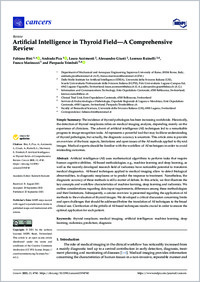Artificial intelligence in thyroid field : a comprehensive review
- Bini, Fabiano Department of Mechanical and Aerospace Engineering, Sapienza-University of Rome, Rome, Italy
- Pica, Andrada Department of Mechanical and Aerospace Engineering, Sapienza-University of Rome, Rome, Italy
- Azzimonti, Laura Istituto Dalle Molle di studi sull'intelligenza artificiale (IDSIA), Facoltà di scienze informatiche, Università della Svizzera italiana, Svizzera
- Giusti, Alessandro Istituto Dalle Molle di studi sull'intelligenza artificiale (IDSIA), Facoltà di scienze informatiche, Università della Svizzera italiana, Svizzera
- Ruinelli, Lorenzo Information and Communications Technology, Ente Ospedaliero Cantonale, Bellinzona, Switzerland - Clinical Trial Unit, Ente Ospedaliero Cantonale, Bellinzona, Switzerland
- Marinozzi, Franco Department of Mechanical and Aerospace Engineering, Sapienza-University of Rome, Rome, Italy
- Trimboli, Pierpaolo Servizio di Endocrinologia e Diabetologia, Ospedale Regionale di Lugano e Mendrisio, Ente Ospedaliero Cantonale, Lugano, Switzerland - Faculty of Biomedical Sciences, Università della Svizzera italiana, Switzerland
-
22.09.2021
Published in:
- Cancers. - MDPI. - 2021, vol. 13, no. 19, p. 18
Thyroid neoplasm
Medical imaging
Artificial intelligence
Machine learning
Deep learning
Radiomics
Prediction
Diagnosis
English
Artificial intelligence (AI) uses mathematical algorithms to perform tasks that require human cognitive abilities. AI-based methodologies, e.g., machine learning and deep learning, as well as the recently developed research field of radiomics have noticeable potential to transform medical diagnostics. AI-based techniques applied to medical imaging allow to detect biological abnormalities, to diagnostic neoplasms or to predict the response to treatment. Nonetheless, the diagnostic accuracy of these methods is still a matter of debate. In this article, we first illustrate the key concepts and workflow characteristics of machine learning, deep learning and radiomics. We outline considerations regarding data input requirements, differences among these methodologies and their limitations. Subsequently, a concise overview is presented regarding the application of AI methods to the evaluation of thyroid images. We developed a critical discussion concerning limits and open challenges that should be addressed before the translation of AI techniques to the broad clinical use. Clarification of the pitfalls of AI-based techniques results crucial in order to ensure the optimal application for each patient.
- Language
-
- English
- Classification
- Medicine
- License
- Open access status
- gold
- Identifiers
-
- RERO DOC 333718
- DOI 10.3390/cancers13194740
- ARK ark:/12658/srd1319322
- Persistent URL
- https://n2t.net/ark:/12658/srd1319322
Statistics
Document views: 266
File downloads:
- Texte intégral: 278
